Case Study 1: Implementing Multicast Support for MPLS VPNs
Case Study 1 Implementing Multicast Support for MPLS VPNs
Multicast VPN or an MPLS VPN capable of supporting multicast packet forwarding does not use MPLS forwarding or a control mechanism but uses MPLS VPN architecture and its associated Multicast Border Gateway Protocol (MBGP) route distribution process. This architecture requires that multicast routing be enabled in the SP core network. The multicast VPN solution provides a reduction in the amount of state information while retaining optimal routing. It maps all the particular VPN multicast groups to a single unique group called the Default Multicast Distribution Tree (Default MDT) in the provider network.
Control and low bandwidth data traffic flows through the default MDT. The solution allows the creation of additional distribution groups called Data Multicast Distribution Trees (Data MDTs) in the SP network to transport high bandwidth sources to points in the network that are signaled to receive traffic. This solution includes the support of multicast routing and forwarding in the context of VPN Routing and Forwarding (VRF) and the use of multicast tunnels over the provider network for control and data connectivity.
Routers in the customer sites that will be a part of the multicast tree will have to be enabled for multicast forwarding on the appropriate interfaces. The provider edge (PE) routers maintain PIM adjacency with the CE routers. The customer can run any multicast routing protocol (SSM or PIM) independent of the multicast protocol running in the provider network. PE routers build a per-VRF default MDT that will be used to distribute data packets and control messages for low bandwidth traffic.
Operation of Multicast MPLS VPN
The operation of a multicast MPLS VPN is as follows:
- Default MDT is enabled per customer VRF on every PE router that will forward multicast packets between customer sites. The VRF on the PE routers thus enabled for multicast forwarding is also called the multicast VRF (mVRF).
- Default MDT enables multicast forwarding for all PEs where the VRF resides.
- Control and data packets are transported per VRF over default MDT. Therefore, all low bandwidth data that is transported over the default MDT will be delivered to PEs where the VRFs reside. Hence, the default MDT is always present.
- A Data MDT for higher bandwidth sources can be created on the PE routers per VRF, and only routers that are part of the multicast tree for the high bandwidth source receive the multicast packets generated by the high bandwidth source. The data MDT is created on demand for mVPN (S, G) higher bandwidth traffic.
MDT group addresses are defined by the provider and are unrelated to the groups used by the customer. Access to the MDT is via a multicast tunnel interface on PE routers where the PE router always functions as the root of the MDT if it is connected to the CE router containing the multicast source.
Figure 14-1 shows an SP network with the default MDT and data MDT concepts highlighted.
Figure 14-1. Multicast MPLS VPN Support Concepts and Operation
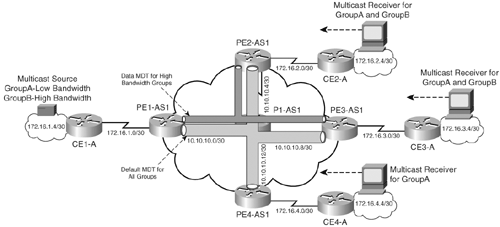
As shown in Figure 14-1, Site 1 sources multicast packets for GroupA and GroupB where GroupA is a low bandwidth source and GroupB is a high bandwidth source. Sites 2 and 3 belonging to Customer A, as well as PE Routers PE2-AS1 and PE3-AS1, receive traffic destined for both groups. As shown in Figure 14-1, the default MDT is formed between all PE routers, and the data MDT is formed only with PE routers connected to sources/receivers of high bandwidth traffic.
Configuration of Multicast Support for MPLS VPN
Configuration to enable multicast support for MPLS VPN is shown in Figure 14-2. The configurations involve enabling multicast as well as a multicast protocol on the interfaces in the customer domain, as well as the provider domain, to forward multicast packets. In addition, the VRF mapping to the customer is enabled for multicast routing using the ip multicast-routing vrf command, and the default and data MDTs are configured under the VRF definition.
Figure 14-2. Multicast MPLS VPN Configuration Flowchart
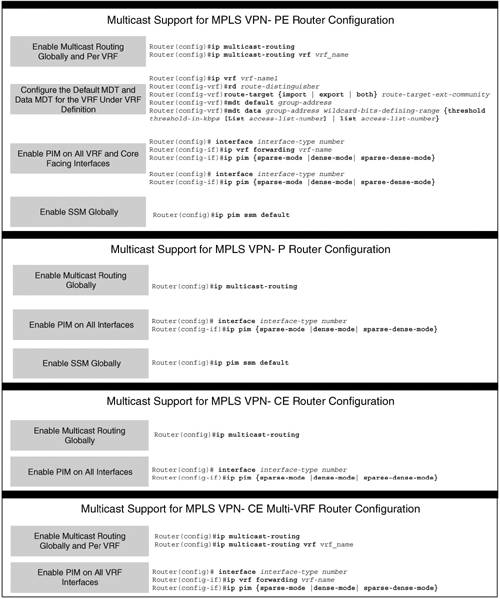
Implementing Multicast Support for MPLS VPNs
Figure 14-3 shows a SP network providing MPLS VPN services to Customer A sites. Customer A, after prior deployment of intersite connectivity using MPLS VPN, would like to also have support for multicast traffic propagation to other sites with receivers that are members of a multicast group.
Figure 14-3. Case Study 1: Multicast MPLS VPN Topology
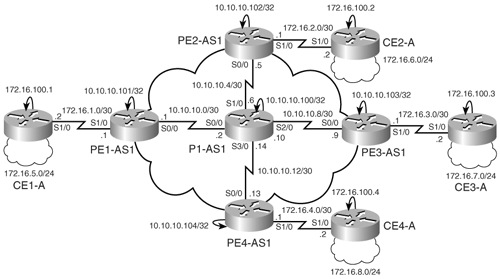
The additional complete configurations on the devices to enable multicast support for MPLS VPN are shown in Figure 14-4. Configurations for PE3-AS1 and PE4-AS1 have not been depicted for brevity and can be derived using the same process as the depicted PE router configurations. As illustrated, the default MDT is configured with a group address of 232.10.0.1, and the data MDT is configured with a group address range of 232.0.0.1 to 232.0.0.255.
Figure 14-4. Case Study 1: Multicast MPLS VPN Configuration
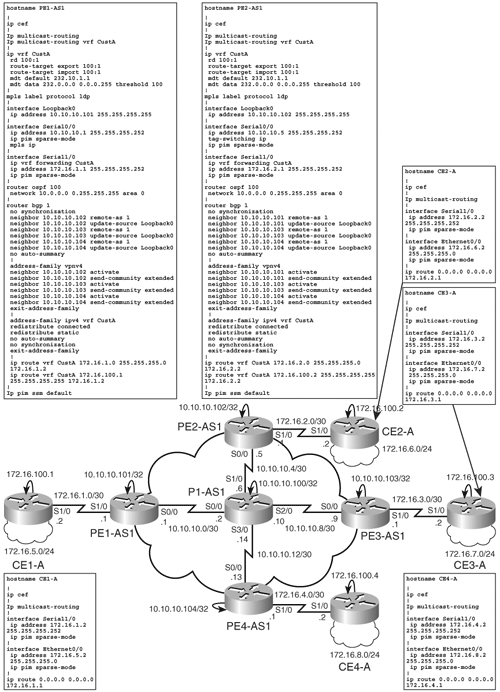
Verifications for Case Study 1
Figure 14-5 shows the verification for the implementation of multicast support for MPLS VPN by performing a show ip mroute on the appropriate devices. As shown in Figure 14-5, the multicast states are propagated via the MP-BGP backbone to CE2-A for the group 232.10.1.1 due to a receiver being connected in Customer A Site 2 for the group.
Figure 14-5. Case Study 1: Multicast MPLS VPN Verification
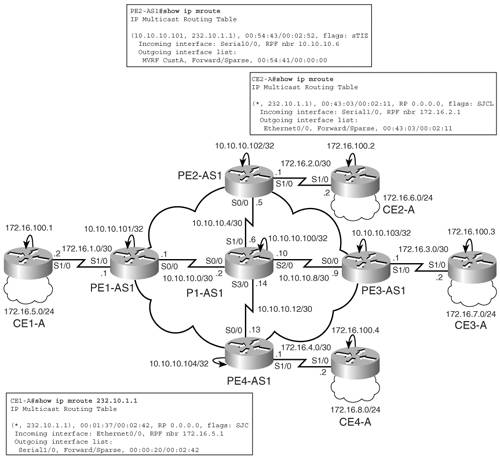
MPLS Overview
- MPLS Overview
- Unicast IP Forwarding in Traditional IP Networks
- Overview of MPLS Forwarding
- MPLS Terminology
- MPLS Control and Data Plane Components
- MPLS Operation
- Special Outgoing Label Types
- Penultimate Hop Popping
- Frame-Mode MPLS
- Cell-Mode MPLS
Basic MPLS Configuration
- Basic MPLS Configuration
- Frame-Mode MPLS Configuration and Verification
- Cell-Mode MPLS over ATM Overview, Configuration, and Verification
- Command Reference
Basic MPLS VPN Overview and Configuration
- Basic MPLS VPN Overview and Configuration
- VPN Categories
- MPLS VPN Architecture and Terminology
- MPLS VPN Routing Model
- MPLS VPN Basic Configuration
- Outbound Route Filters
- Command Reference
PE-CE Routing Protocol-Static and RIP
- PE-CE Routing Protocol-Static and RIP
- Static PE-CE Routing Overview, Configuration, and Verification
- Static PE-CE Routing Command Reference
- RIPv2 PE-CE Routing Overview, Configuration, and Verification
- RIPv1 PE-CE Routing Configuration and Verification
- RIP PE-CE Routing Command Reference
PE-CE Routing Protocol-OSPF and EIGRP
- PE-CE Routing Protocol-OSPF and EIGRP
- OSPF PE-CE Routing Protocol Overview, Configuration and Verification
- EIGRP PE-CE Routing Protocol Overview, Configuration, and Verification
Implementing BGP in MPLS VPNs
- Implementing BGP in MPLS VPNs
- BGP PE-CE Routing Protocol Overview, Configuration, and Verification
- Implementing Route-Reflectors in MPLS VPN Networks
- Case Study-Hub and Spoke MPLS VPN Network Using BGP PE-CE Routing for Sites Using Unique AS Numbers
- Case Study-Hub and Spoke MPLS VPN Network with Sites Using Same AS Numbers
- Command Reference
Inter-Provider VPNs
- Inter-Provider VPNs
- Overview of Inter-Provider VPNs
- Option 1: Inter-Provider VPN Using Back-to-Back VRF Method
- Option 2: Inter-Provider VPNs Using ASBR-to-ASBR Approach
- Option 3: Multi-Hop MP-eBGP Between RR and eBGP Between ASBRs
- Option 4: Non-VPN Transit Provider
- Case Study-Inter-AS Implementing Route-Reflector and BGP Confederation in Provider Networks
- Case Study-Multi-Homed Inter-AS Provider Network
- Command Reference
Carrier Supporting Carriers
- Carrier Supporting Carriers
- Carrier Supporting Carriers Overview
- Deployment Scenarios with CSC Architecture
- CSC Architecture Benefits
- Command Reference
MPLS Traffic Engineering
- MPLS Traffic Engineering
- TE Basics
- MPLS TE Theory
- Constraint-Based Routing and Operation in MPLS TE
- Configuring MPLS TE
- Command Reference
Implementing VPNs with Layer 2 Tunneling Protocol Version 3
- Implementing VPNs with Layer 2 Tunneling Protocol Version 3
- L2TPv3 Overview
- Configuring L2TPv3 Tunnels for Layer 2 VPN
- Configuring L2TPv3 Static Tunnels
- Configuring L2TPv3 Dynamic Tunnels
- Implementing Layer 3 VPNs over L2TPv3 Tunnels
- Command Reference
Any Transport over MPLS (AToM)
- Any Transport over MPLS (AToM)
- Introduction to Layer 2 VPNs
- Implementing AToM for Like to Like Circuits
- L2 VPN-Any to Any Interworking
- Local Switching
- Command Reference
Virtual Private LAN Service (VPLS)
- Virtual Private LAN Service (VPLS)
- VPLS Overview
- VPLS Topology-Single PE or Direct Attachment
- Hierarchical VPLS-Distributed PE Architecture
- Command Reference
Implementing Quality of Service in MPLS Networks
- Implementing Quality of Service in MPLS Networks
- Introduction to QoS-Classification and Marking
- MPLS QoS Implementation
- MPLS QoS Operating Modes
- Modular QoS CLI: Configuration of QoS on Cisco Routers
- Configuration and Implementation of MPLS QoS in Uniform Mode and Short Pipe Mode Operation
- Implementing MPLS QoS for Layer 2 VPN Implementations
- Command Reference
MPLS Features and Case Studies
- MPLS Features and Case Studies
- Case Study 1: Implementing Multicast Support for MPLS VPNs
- Case Study 2: Implementing Multi-VRF CE, VRF Selection Using Source IP Address, VRF Selection Using Policy-Based Routing, NAT and HSRP Support in MPLS VPN, and Multicast VPN Support over Multi-VRF CE
- Case Study 3: Implementing Layer 2 VPNs over Inter-AS Topologies Using Layer 2 VPN Pseudo-Wire Switching
- Case Study 4: Implementing Layer 3 VPNs over Layer 2 VPN Topologies and Providing L2 VPN Redundancy
- Case Study 5: Implementing Dynamic Layer 3 VPNs Using mGRE Tunnels
- Case Study 6: Implementing Class-Based Tunnel Selection with MPLS Traffic Engineering
- Case Study 7: Implementing Hub and Spoke Topologies with OSPF
- Case Study 8: Implementing Hub and Spoke Topologies with EIGRP
- Case Study 9: Implementing VPLS Services with the GSR 12000 Series
- Case Study 10: BGP Site of Origin
- Command Reference
EAN: 2147483647
Pages: 130
